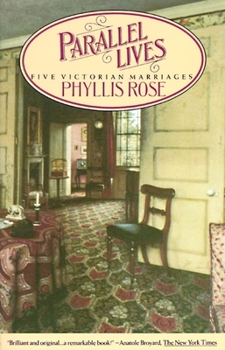Parallel Lives: Five Victorian Marriages
Select Format
Select Condition 
Book Overview
In her study of the married couple as the smallest political unit, Phyllis Rose uses as examples the marriages of five Victorian writers who wrote about their own lives with unusual candor.
Format:Paperback
Language:English
ISBN:0394725808
ISBN13:9780394725802
Release Date:October 1984
Publisher:Vintage
Length:336 Pages
Weight:0.69 lbs.
Dimensions:0.9" x 5.2" x 7.9"
Customer Reviews
4 ratings
Great Read
Published by Thriftbooks.com User , 19 years ago
I read this book when it first came out and just re read it. The people then are just like people now. A gossipy fun book
Victoriana
Published by Thriftbooks.com User , 20 years ago
The author avers that every marriage is a narrative construct. Phyllis Rose describes the courtship and decision to marry of Jane Welsh and Thomas Carlyle. The extraordinary and almost exclusive connection of John Ruskin with his parents is depicted. The thought-out plan of Frances and Charles Kingsley in the first four weeks of marriage is presented by way of contrast to the circumstances of John Ruskin and Effie Gray. Effie and John were troubled both by their own relationship and pulls and ties from their respective families. Ruskin was never to express remorse for his behavior. He did not understnd that he was partly at fault in the break up of his marriage. The views of Effie and John could not be reconciled. The story of the Ruskins anticipates MIDDLEMARCH. Ruskin admired John Everett Millais. Effie was a model for one of the paintings of Millais. The Ruskins and Millais and others spent four months together on a sort of extended reading party in Scotland. After six years the Ruskins reached a stalemate. Effie sought practical advice from Lady Eastlake whose husband headed the Royal Academy. She advised her to confide in her parents. There was a dramatic flight and the serving of papers. Ruskin's domestic calamities were less important to him than Turner's death. Eventually Effie and Millais had eight children. Harriet and John Taylor were Unitarians. They had an enlightened circle. Harriet was introduced to John Stuart Mill by her minister to divert her attention from marital incompatibilities. The Taylors and Mill formed a triangle. Two years after her husband's death Harriet agreed to become Mrs. Mill. Both Harriet and John Stuart Mill had been made lonely by exceptional intelligence. Mill's mind was a marvel, but he initiated nothing. Harriet served an executive function in the production of his books and articles. Mill's autobiography was written as a defense of his wife. Catherine Hogarth attended a birthday party Charles Dickens gave himself. She was twenty. Dickens was astonishing for his outpouring of invention. Ambitious men marry young. Dickens had devoted male companions and in the early years of his marriage enjoyed domestic happiness. After 1850 Dickens changed. He craved emotional intensity with another person. At the time of starting LITTLE DORRIT restlessness tormented him. He turned to the theater, to acting. Her met Ellen Ternan and began a sentimental attachment. In later life Kate Dickens felt she and the other children were wicked not to take their mother's part. The domestic life of George Henry Lewes and George Eliot centered on work. George Eliot seized her identity as a writer from her union with Lewes. The couple was spared the pursuit of respectibility. Notes, bibliography, and a timeline appear at the back of the book. This book has been well-known and lavishly praised since it was issued. Nothing about it changes the high estimation bestowed previously. T
A Relevant Exploration of Marriage
Published by Thriftbooks.com User , 22 years ago
Phyllis Rose' Parellel Lives is an exploration of marriage: what makes a marriage, how marriages operate, the power struggles within marriage, the impact of patriarchy on marriage, sexuality within marriage and many, many other issues. Ms Rose uses Victorian marriages to discuss these issues. This is a perceptive move. Our current culture, filled with self-help manuals and marriage classes, is in some ways less tolerate of eccentricity, more assured about how a successful marriage should operate. The tensions of sexuality, power and so on have been addressed, if not by individuals, within the culture and media at large. But Victorians did not have such an outlet. Dickens didn't know he was experiencing a well-documented male mid-life crisis when he engineered he and his wife's separation. This lack of self-knowledge makes the exploration of such marriages a fascinating study in human nature. The book is split into the marriage biographies of five couples with two sections on Jane Welsh and Thomas Carlyle. A refreshing aspect of Ms Rose's Parallel Lives is that she is exploring these marriages from a feminist viewpoint that encompasses compassion for the man as well as for the woman. Her prose style is lively as she delves into the separate personal stories of her couples and how their personal stories influenced the marriage as a whole. The book suffers a bit at the end. Ms Rose pulls back and attempts to apply general theory to her analysis. This is mostly unsuccessful. Ms Rose's gift lies in the personal--her ability to unravel this or that particular marriage and how this or that particular marriage was influenced by the problems of patricarchy--not in a general ideological stance that would supposedly solve those problems. Recommendation: An intelligent and perceptive read. Buy it!
A gem!
Published by Thriftbooks.com User , 24 years ago
Wonderfully balanced and perceptive, this probing look at five unconventional Victorian marriages provides many insights into the sexual mores of that era. The section on the novelist George Eliot is especially haunting.





